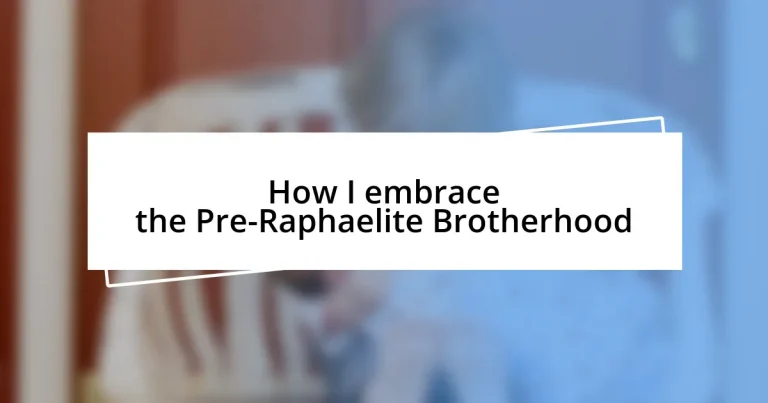Key takeaways:
- The Pre-Raphaelite Brotherhood, founded in 1848, challenged the rigid conventions of the Royal Academy, seeking to return to vibrant, emotive art focused on realism and nature.
- Key principles of Pre-Raphaelite art include meticulous attention to detail, rich symbolism, and emotional expression, creating artworks that resonate personally with viewers.
- The movement’s influence persists in contemporary culture, inspiring modern artists, fashion designers, and filmmakers to explore themes of beauty, love, and nature.
- Personal engagement with Pre-Raphaelite ideals, such as immersing in nature and storytelling, enriches one’s life and fosters a deeper emotional connection to art and experience.
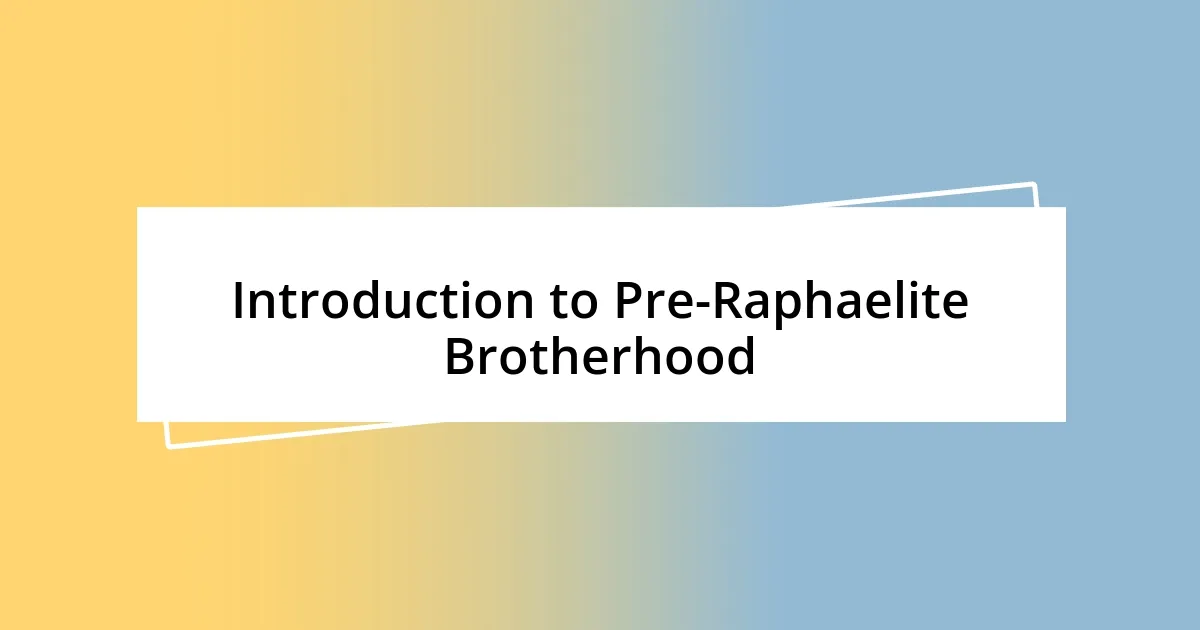
Introduction to Pre-Raphaelite Brotherhood
The Pre-Raphaelite Brotherhood, founded in 1848, was a revolutionary group of artists and writers who sought to challenge the academic standards of their time. Imagine walking through a gallery filled with vibrant colors, intricate details, and passionately emotive subjects—each piece telling a story of beauty and idealism that beckons you to explore deeper. It’s fascinating to consider how their desire to return to the techniques before Raphael reflected a longing for authenticity in a rapidly industrializing world.
I remember the first time I encountered a Pre-Raphaelite painting; it felt as though I had stepped into a dream. The lush landscapes and enchanting figures sparkled with life, pulling me into their narratives. How could something painted over a century ago resonate so deeply with emotions I often grappled with? This is the essence of the Brotherhood—they ignited a sense of connection across time, inviting us to question our own realities.
Moreover, the Brotherhood was more than just an art movement; it was a creative rebellion, fueled by the collective passions of its founding members, including Dante Gabriel Rossetti and William Holman Hunt. Their works not only showcased technical prowess but also embraced themes of love, death, and nature, often infused with rich symbolism. Engaging with their creations encourages us to reflect on our interpretations of art and emotion—what does beauty mean to you?
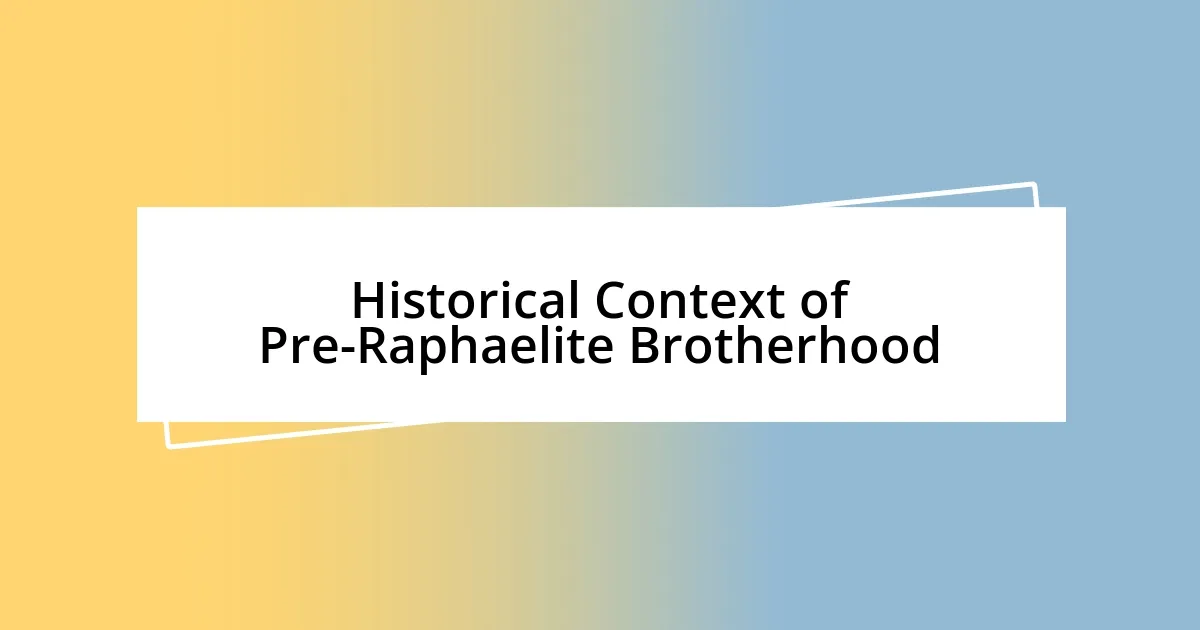
Historical Context of Pre-Raphaelite Brotherhood
The formation of the Pre-Raphaelite Brotherhood emerged during a period of significant social and artistic upheaval in the mid-19th century. At that time, the British art scene was dominated by the Royal Academy’s rigid standards, favoring neoclassicism and historical subjects. The Brotherhood’s members, yearning for a return to the more vibrant, expressive styles before Raphael, resisted these conventions and looked back to medieval themes and naturalism, aspiring to create art that resonated with real emotions and experiences.
- Founded in 1848 by Dante Gabriel Rossetti, William Holman Hunt, and John Everett Millais.
- Reacted against the ideals of the Royal Academy, promoting art that emphasized emotion and realism.
- Influenced by literary works, particularly those of Shakespeare and Tennyson, integrating rich storytelling into visual art.
- Arose during the Industrial Revolution, reflecting concerns about urbanization and the loss of connection to nature.
- Featured an appreciation for intricate details, bright colors, and symbolic narratives that spoke on a personal level.
I find it intriguing how the Brotherhood’s rebellion was not just artistic but also philosophical. As I explored their works, it became clear that their paintings were windows to a world that cherished simplicity and depth. Each brushstroke seemed to echo a call for authenticity in an era where mass production and mechanization were swiftly taking over, reminding me of how we often seek genuine beauty in our own lives, even when surrounded by the chaos of modernity.
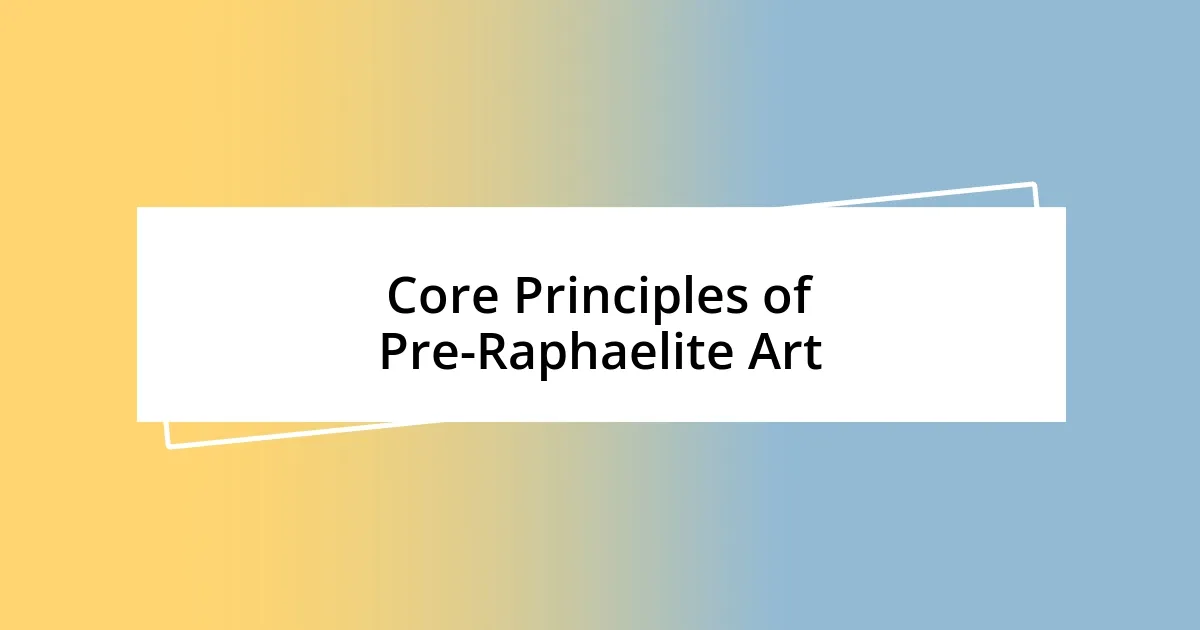
Core Principles of Pre-Raphaelite Art
The core principles of Pre-Raphaelite art are steeped in a commitment to detail, color, and narrative depth. One of the most striking elements is the dedication to realism and nature; the artists often painted from direct observation, showcasing their subjects in extraordinary detail. I remember being captivated by how the leaves in Millais’ “Ophelia” appeared almost vivid enough to touch, making me feel as though I could step right into the scene. It’s this meticulous attention to the natural world that truly sets Pre-Raphaelite art apart.
Symbolism is another cornerstone of their work. Each piece often contained layers of meaning, drawing from literature and mythology to evoke emotional responses. I recall being deeply moved while studying Rossetti’s “The Blessed Damozel.” It wasn’t just the breathtaking beauty of the woman depicted; it was the rich backstory and the sense of longing that resonated deeply with my own experiences of love and loss. This interplay of visual beauty and symbolic narrative invites viewers to delve into their own emotions and interpretations.
Lastly, the emphasis on emotional expression stands out prominently in Pre-Raphaelite art. The artists aimed to capture not just the physical likeness of their subjects but their emotional states as well. This conviction reminds me of a time I gazed at Hunt’s “The Awakening Conscience”—the subtlety of the woman’s expression stirred something within me, sparking a reflection on moments of awakening in my own life. Each artwork serves as a reminder that art is not merely about what we see but also about what we feel and understand on a personal level.
| Core Principle | Description |
|---|---|
| Detail and Realism | Artworks focused on intricate details and vivid representations of nature and human form, achieved through direct observation. |
| Symbolism | Each piece carries rich narratives from literature and mythology, offering multiple layers of meaning that invite personal interpretation. |
| Emotional Expression | Artists aimed to capture the emotional essence of their subjects, linking their works to deeper human experiences. |

Collecting Pre-Raphaelite Artworks
Collecting Pre-Raphaelite artworks is a journey into the heart of a vibrant, romantic movement. When I first encountered a painting by Millais, I was struck by how the colors practically sang off the canvas. It felt like stepping into a different era, where my surroundings faded, and I became immersed in the emotional depth and intricate details of the artwork. Each piece I’ve collected carries with it a story that resonates with my own experiences, almost as if the artists were whispering their secrets through their brushstrokes.
As I built my collection, I learned that provenance—meaning the history of ownership of a piece—plays a crucial role in value appreciation. I remember vividly the thrill of acquiring a smaller piece that once belonged to a renowned collector. Holding it in my hands felt like grasping a fragment of history, a tangible connection to the past. Isn’t it fascinating how artworks can encapsulate such rich narratives and histories? This realization made each acquisition not just an addition to my collection but a piece of legacy that links me to the very ideals the Brotherhood stood for.
The thrill of discovering hidden gems in auctions or galleries is indescribable. I recall attending a local auction where I stumbled upon a lesser-known work that captivated me. It wasn’t a household name, but it echoed the fundamental Pre-Raphaelite themes of nature and love. The moment I bid on it, my heart raced, knowing I was advocating for a piece of art that, like me, might yearn for recognition. It’s moments like these that remind me that collecting is not just about ownership but about honoring the beauty and emotion encapsulated in each piece.

Incorporating Pre-Raphaelite Ideas in Life
Incorporating Pre-Raphaelite ideas into daily life can be an enriching journey. One striking way I’ve embraced their principles is by immersing myself in nature. I often find solace in taking long walks, where I observe the intricate details of flowers and trees, very much like the Pre-Raphaelites did. Have you ever paused to actually notice the layers of color in a single leaf? Each time I do, I feel a rekindling of that vivid artistic detail, linking me back to their commitment to realism and natural beauty.
Another way I embrace their philosophy is through storytelling. I make it a ritual to read literature steeped in rich imagery and emotional depth, much like the narratives found in Pre-Raphaelite art. Recently, I revisited “Tenniel’s Alice in Wonderland,” and the symbolism leaped off the pages in ways I hadn’t noticed before. It made me wonder—how can we all delve deeper into the stories that shape our lives? By connecting with the emotional essence of the narratives I engage with, I not only honor the artists’ legacies but also spark introspection in my own life.
Finally, I find ways to express my emotions creatively, whether through writing, painting, or even cooking. There’s something exhilarating about creating a piece of art or a dish that reflects not just my mood but the emotions swirling around me, echoing a sentiment often portrayed in Pre-Raphaelite works. Last week, I captured my feelings in a watercolor painting that resembled the dreamy quality I see in Rossetti’s pieces. The simple act of translating my emotions into a visual format offered therapeutic release, showing me that creativity isn’t just about the final product—it’s about the emotional journey it sparks within us.
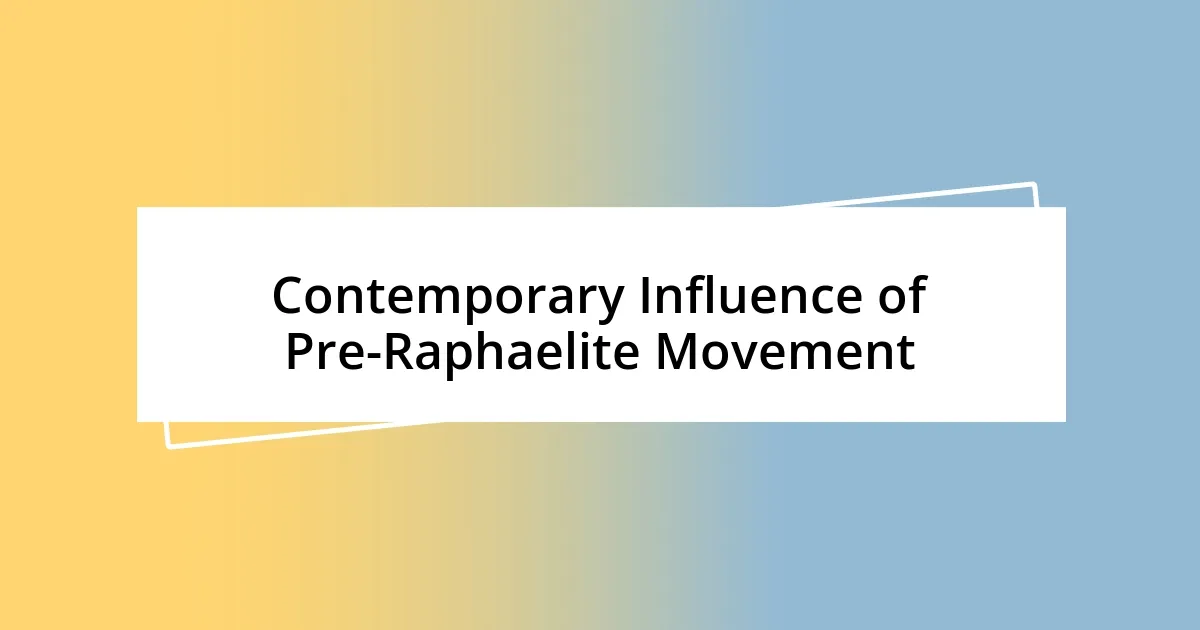
Contemporary Influence of Pre-Raphaelite Movement
The Pre-Raphaelite movement continues to ripple through contemporary art and culture, inspiring a resurgence of interest in its vivid storytelling and emotive imagery. I recently attended an art exhibit showcasing modern artists who draw heavily from Pre-Raphaelite themes. It was fascinating to see how these contemporary creators weave intricate narratives and lush colors into their work, echoing the Brotherhood’s commitment to beauty and authenticity. Don’t you ever wonder how the values of a 19th-century art movement can feel so relevant today?
Another striking influence I’ve observed is in fashion. Designers today often channel the romantic aesthetics and Victorian styles synonymous with the Pre-Raphaelites. I remember watching a fashion show where models paraded in flowing gowns adorned with floral motifs and intricate lace—elements directly reminiscent of paintings by artists like John Everett Millais. It made me reflect on how art, in any form, evolves yet remains wonderfully connected to its historical roots. Isn’t it intriguing how creativity knows no bounds and continually influences new avenues of expression?
Moreover, the ideals of the Pre-Raphaelite Brotherhood have permeated literature and film, where narratives often echo their thematic focus on love, nature, and socio-political commentary. I recently watched a film adaptation of a classic novel, and it struck me how the cinematography captured a lush, dreamlike world so reminiscent of Dante Gabriel Rossetti’s paintings. As the scenes unfolded, I felt enveloped in a tapestry of desires and struggles almost like stepping directly into one of their works. How does this blending of the past influence our understanding of contemporary storytelling? The answer lies in the timelessness of their artistry, continuously reinvigorating our worldview through new interpretations.

Personal Reflections and Experiences
One evening, I found myself wrapped up in the colors of a sunset, shades of orange swirling into deep indigo. It reminded me of how Pre-Raphaelite artists portrayed light and atmosphere in their work, capturing fleeting moments with such intensity. Have you ever watched a sunset and felt it tell a story? That evening, it dawned on me that every moment has the potential for artistic expression, just waiting for us to notice it.
When I first stumbled across the poetry of Christina Rossetti, I didn’t expect her words to resonate so deeply within my soul. After reading “Goblin Market,” I felt a mixture of delight and sorrow that lingered long after I closed the book. What was it that drew me in so profoundly? I realized that her exploration of sisterhood and sacrifice spoke to my own life experiences, reminding me that art can mirror our struggles and joys, creating a personal connection that lasts.
At a local gallery featuring contemporary adaptations of Pre-Raphaelite themes, I came across an installation that combined traditional painting with modern technology. Watching visitors interact with the artwork, their laughter and gasps of awe were contagious. I couldn’t help but think—how does art not only reflect our history but also enhance our collective experiences in this fast-paced age? In that moment, I felt an exhilarating sense of community, all of us linked by the timeless influence of the Pre-Raphaelite Brotherhood, each seeking connection through shared emotions and beauty.












